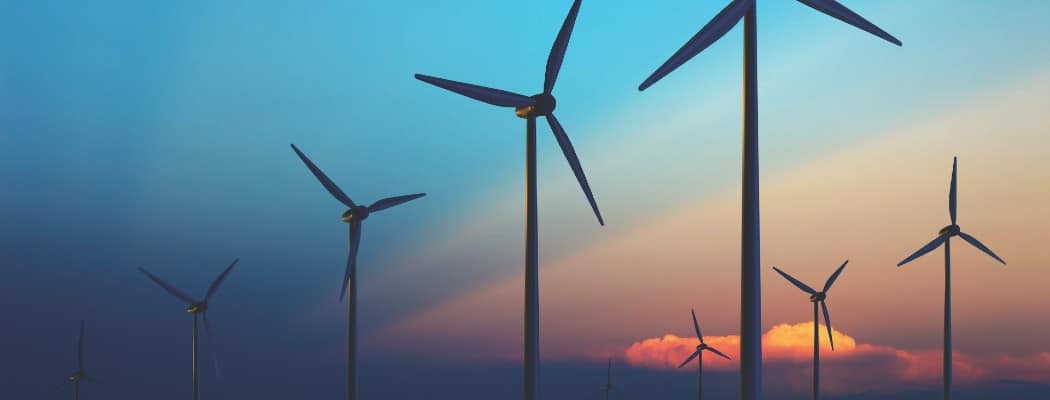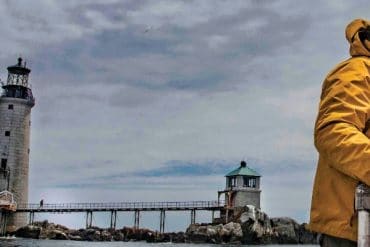The high-stakes energy game of Vineyard Wind.
New England is known for its revolutionary spirit. But twenty years ago, when Cape Wind proposed an offshore wind revolution, the project was lost in a sea of opposing lawsuits. Supporters saw a clean energy industry that could address environmental woes and revitalize the economy, while opponents couldn’t see past the wind turbines— monumental eyesores to be situated in pristine Nantucket Sound.

After almost two decades of extreme weather events, Vineyard Wind has stepped confidently into the wake of Cape Wind’s failure—now with the full support of state and federal governments, even as marine scientists, environmental activists and fishing groups continue to decry the paucity of data on the potential impacts of large-scale off-shore wind development in the U.S. Northeast Shelf large marine ecosystem.
Offshore wind is a vital part of President Biden’s climate strategy, and at least sixteen offshore wind projects are poised for development along the Eastern Seaboard. Vineyard Wind I—an 800-megawatt wind farm currently being developed on 166,886 acres of federally leased waters just twelve nautical miles southwest of Madaket—is the first utility-scale offshore wind project in the United States. A joint venture between Avangrid Renewables and Copenhagen Infrastructure Partners, the company reached a critical milestone in mid-September when it secured nearly $2.3 billion in senior debt and investments from a consortium of global banks, including J.P. Morgan, Bank of America, BBVA, NatWest, Santander, Crédit Agricole, Natixis, BNP Paribas and MUFG Bank.
The financial close allowed Vineyard Wind to marshal its contractors and suppliers, including GE, which in mid-October announced a deal for sixty-two of its state-of-the-art thirteen-megawatt Haliade-X turbines. Each colossal 260-meter (853-foot) tower supports a 220-meter rotor with individual blades longer than a football field, for a “swept area” of 38,000 square meters—just two rotations of a single blade can power the average Massachusetts home for a day.
With all of the turbines working together at full capacity, Vineyard Wind I should be able to power more than 400,000 homes annually. In terms of carbon emissions reductions, that’s 1.68 million tons—the rough equivalent of taking 325,000 cars off the road. Over the projected twenty-five-year lifespan of the project (offshore wind facilities are typically decommissioned after twenty to twenty-five years due to increased maintenance costs), Massachusetts residents can expect to see a cumulative $3.7 billion in energy cost savings, starting in 2023.
For Vineyard Wind CEO Lars Pedersen, it is as much about economic opportunity as it is about tackling the climate crisis. “Vineyard Wind will not only ensure that Massachusetts is the hub of the offshore wind industry in the United States, it will deliver exceptional opportunities for the creation of new jobs and millions of dollars in much-needed state and local taxes,” he says. “There are many advantages associated with Massachusetts getting a head start as host of the nation’s first commercial-scale offshore wind power generation facility, but none as important as the direct economic benefits for Bay State residents.”

Pedersen claims that “a lot of the workforce will be an American workforce,” but to date has not shared specific data about jobs. Vineyard Wind discusses job creation in terms of “full- time equivalent” jobs and “job years”—talking points that blur the distinction between longterm full-time employment and temporary full-time employment (a “job year” indicates that one full-time employee will work for a year, but twenty-five job years is not necessarily twenty-five jobs—it could be one person working for twenty- five years). Such language tends to confuse the public and conflate the numbers.
A 2017 study on Vineyard Wind I by the former UMass Dartmouth Public Policy Center projected that Vineyard Wind would create from 1,706 to 2,120 full-time jobs over a period of twenty-five years, most lasting just a few years during initial construction phases, with only about eighty long-term operations and maintenance positions. Vineyard Wind is funding and implementing its own $2 million Windward Workforce program to “recruit, mentor, and train residents of Massachusetts,” with a special focus on Martha’s Vineyard, where it aims to have an all-local staff within five years of the project being operational.
 With the U.S. offshore wind manufacturing and supply chain sectors still largely undeveloped (i.e., American wind facilities are being built with European parts), the Southeastern Massachusetts Building Trades Council, an organization that represents thousands of pipe fitters, electricians, carpenters and pile drivers from the South Coast and the Cape and Islands, will play an important role in getting American offshore wind workers up to speed with those in Europe and China. To that effect, Vineyard Wind has recently committed to hiring at least 500 union laborers in southeastern Massachusetts, including New Bedford, Fall River, Cape Cod, Martha’s Vineyard and Nantucket, with additional workers with prior offshore wind experience to come from Europe. The agreement also allocates $500,000 to recruit and train workers from underserved communities.
With the U.S. offshore wind manufacturing and supply chain sectors still largely undeveloped (i.e., American wind facilities are being built with European parts), the Southeastern Massachusetts Building Trades Council, an organization that represents thousands of pipe fitters, electricians, carpenters and pile drivers from the South Coast and the Cape and Islands, will play an important role in getting American offshore wind workers up to speed with those in Europe and China. To that effect, Vineyard Wind has recently committed to hiring at least 500 union laborers in southeastern Massachusetts, including New Bedford, Fall River, Cape Cod, Martha’s Vineyard and Nantucket, with additional workers with prior offshore wind experience to come from Europe. The agreement also allocates $500,000 to recruit and train workers from underserved communities.
A 2021 analysis by the American Clean Power Association cites a need for 12,000 wind turbine technicians in the next decade. It follows that there will be no shortage of opportunities available to New Englanders who endeavor to take on what has been characterized as mentally and physically demanding, even potentially dangerous work. Vineyard Wind I (not to be confused with Vineyard Wind South or Park City Wind, other Vineyard Wind projects under development) is only one of six offshore wind facilities currently destined for the coastal waters of New England—an area which, due to its consistently high winds and shallow waters, has been dubbed by Massachusetts Senator Ed Markey as “the Saudi Arabia of offshore wind for the planet.”
Such gold rush rhetoric has stoked support for the ten more proposed offshore wind projects stretching south from New England to the Carolinas. A recent white paper from the Special Initiative on Offshore Wind at the University of Delaware projected that, by 2030, offshore wind will be a $70 billion business pipeline in the United States.
While support for offshore wind development gains momentum, some federal, state and local agencies have urged caution, expressing serious concerns about the potential impacts of large-scale industrial development on a fertile and diverse marine ecosystem already subject to competing interests between conservationists and the fishing industry.
Nantucket Sound is encompassed by the Atlantic Outer Continental Shelf, an area regarded by the scientific community as a “frontier region.” Of chief concern among scientists is the lack of data on the impact of offshore wind development on site-specific marine ecosystems, including the effects of pile-driving and vessel noise on species’ behavior, movements and migratory patterns; soft bottom habitat reduction; modified hydrodynamic patterns; and electromagnetic field emissions from transmission cabling.
Persistent, high levels of underwater acoustic disturbances associated with the construction and operation of offshore wind facilities are of particular concern to the survival of migratory species such as the critically endangered North Atlantic right whale, which uses echolocation to navigate. It’s important to emphasize how differently sound behaves in the ocean—it travels five times more efficiently under water than it does through the air, and it must be measured relative to both acoustic pressure and particle motion when addressing the potential effect on marine mammals, fishes and invertebrates, because of complex biological adaptations that enhance detection of these factors. Data that accurately measures the impact of offshore wind production on marine ecosystems is scarce, in part, because particle motion can’t easily be predicted near boundaries such as the surface of the sea or the seafloor. However, the particle motion component is thought to be far more relevant to important fishery species.
 Studies examining the cumulative effects of exposure to pile-driving noise show diverse impacts including altered hydrodynamic patterns around offshore wind facilities that may affect larval dispersal and the distribution of zooplankton, resulting in systemic changes to the food chain. Larger species such as whales and endangered finfish may experience changes in behaviors and migratory patterns due to both acoustic disturbances and electromagnetic field emissions from subsea cables, making them more vulnerable to serious in- jury or mortality from ship strikes. Mussels and other shellfish proliferating on the underwater portion of wind turbine towers—the so-called artificial reef effect—can potentially increase the abundance of prey species and therefore exacerbate competition between recreational and commercial fisheries and highly migratory finfish such as blue sharks, effectively creating de facto exclusionary fishing areas around offshore wind developments.
Studies examining the cumulative effects of exposure to pile-driving noise show diverse impacts including altered hydrodynamic patterns around offshore wind facilities that may affect larval dispersal and the distribution of zooplankton, resulting in systemic changes to the food chain. Larger species such as whales and endangered finfish may experience changes in behaviors and migratory patterns due to both acoustic disturbances and electromagnetic field emissions from subsea cables, making them more vulnerable to serious in- jury or mortality from ship strikes. Mussels and other shellfish proliferating on the underwater portion of wind turbine towers—the so-called artificial reef effect—can potentially increase the abundance of prey species and therefore exacerbate competition between recreational and commercial fisheries and highly migratory finfish such as blue sharks, effectively creating de facto exclusionary fishing areas around offshore wind developments.
The Greater Atlantic Regional Fisheries Office of NOAA Fisheries, the Massachusetts Division of Marine Fisheries (DMF) and the New Bedford Port Authority Fisheries Advisory Committee on Off-shore Wind outlined recommendations to the Bureau of Ocean Energy Management (BOEM) in 2018, at the start of a fragmented, three-year review process on Vineyard Wind I conducted during the transition between the Trump and Biden administrations and the ongoing coronavirus pandemic.
Fishing groups claim the direct overlap between Vineyard Wind’s lease sites and prime fishing areas will likely have a devastating impact. “NOAA emphasizes in great detail these wind energy installations will be ocean-altering, both individually and cumulatively. These projects raise valid concerns regarding historic livelihoods, essential fish habitat and fish populations, not to mention endangered and threatened species,” said David Frulla, an attorney representing the Fisheries Survival Fund.
Potentially adverse effects, Vineyard Wind claims, may be offset by benefits associated with a reduction in greenhouse gases. Dr. David Pierce, former director of the Massachusetts DMF, argued, “While the proposed project will provide an alternative to fossil fuel-derived energy, reductions in greenhouse gas emissions from the Vineyard Wind project alone are unlikely to provide local benefits to marine mammals and other marine life that currently occupy the project area, particularly large whales that use these waters as foraging habitat. If this logic is being used to justify adverse impacts on local populations of marine species, quantifying the GHG reduction benefits is necessary and should include associated construction costs.”
In 2019 Vineyard Wind issued an agreement with the Conservation Law Foundation, the National Wildlife Federation and the National Resources Defense Council to restrict turbine construction in the winter and early spring, when North Atlantic right whales are known to frequent the area, to surveil the ocean and limit construction noise, to enforce vessel speed limits and to invest $3 million into technologies that will help protect the critically endangered species.
Vineyard Wind has since doled out $1.9 million to the UMass Dartmouth School for Marine Science and Technology “to assess the impact of wind farm construction on fish populations through surveys carried out pre-and post-construction,” compensating local fishermen to assist students and scientists in the collection of data, and $37.7 million to commercial fishermen in Massachusetts and Rhode Island to compensate them for future losses. For the rights to land transmission cables at Covell’s Beach, Vineyard Wind has agreed to pay the town of Barnstable up to $16 million, plus taxes, over the next twenty-five years.
 Although the only part of the project to fall directly under Nantucket jurisdiction is an undersea cable running through the Muskeget Channel, in 2020 the company also committed to paying the Town of Nantucket $34 million over the next forty-five years. The agreement came after BOEM released a 2019 Finding of Adverse Effect on the Gay Head Lighthouse and the Nantucket Island National Historic Landmark. Vineyard Wind agreed to shift a row of turbines back, equip them with a more efficient aircraft detection lighting system and paint them a nonreflective gray color. The first $16 million of the company’s “community benefit fund” will come over the next eight to ten years, with the caveat that town officials and nonprofit leaders must not divulge how funds will be allocated until Vineyard Wind closes on the project, and that they will support the company until the federal permitting process is complete. Funds will be administered by the Community Foundation for Nantucket and will include potential support for island nonprofits, historic preservation and restoration, coastal resilience and climate adaptation measures, and mitigation for future offshore wind projects.
Although the only part of the project to fall directly under Nantucket jurisdiction is an undersea cable running through the Muskeget Channel, in 2020 the company also committed to paying the Town of Nantucket $34 million over the next forty-five years. The agreement came after BOEM released a 2019 Finding of Adverse Effect on the Gay Head Lighthouse and the Nantucket Island National Historic Landmark. Vineyard Wind agreed to shift a row of turbines back, equip them with a more efficient aircraft detection lighting system and paint them a nonreflective gray color. The first $16 million of the company’s “community benefit fund” will come over the next eight to ten years, with the caveat that town officials and nonprofit leaders must not divulge how funds will be allocated until Vineyard Wind closes on the project, and that they will support the company until the federal permitting process is complete. Funds will be administered by the Community Foundation for Nantucket and will include potential support for island nonprofits, historic preservation and restoration, coastal resilience and climate adaptation measures, and mitigation for future offshore wind projects.
Throughout the permit review process, environmental groups, including the National Wildlife Federation, Natural Resources Defense Council, Conservation Law Foundation, Defenders of Wildlife, Mass Audubon, Audubon Society of Rhode Island, Environmental League of Massachusetts, Whale and Dolphin Conservation North America, Humane Society of the United States, NY4WHALES and the American Bird Conservancy, expressed concerns and submitted recommendations to BOEM, which, in July 2019 announced a delay of the federal environmental review process only to then abruptly announce the review’s completion after the change in administration, leading to what some groups claim was hasty approval of the Vineyard Wind I Environmental Impact Statement—a four-volume, 2,422-page document costing U.S. taxpayers upward of $3,539,425.
In March 2021 BOEM released the Final Environmental Impact Statement (FEIS). Two months later the Biden administration granted a Record of Decision after an “exhaustive” three-year public review process. The FEIS contains thorough and detailed legalese compiled by dozens of government agencies outlining and reviewing the Vineyard Wind I project’s construction and operations plans, as well as what are considered to be anticipated reasonable risks to and loss of marine life and fishing habitat, citing a majority of “negligible,” “minor,” “moderate” and “moderate beneficial” impacts, many “in the context of reasonably foreseeable environmental trends”’ in lieu of actual site-specific data, underscoring concerns that the implementation of Vineyard Wind I is de facto research.
The most outspoken opponents of Vineyard Wind I are an unlikely cast of characters that includes environmentalists like journalist Michael Shellenberger, who favors nuclear energy over land-intensive, short-lived wind facilities; fishing advocacy groups like the Responsible Offshore Development Agency (RODA); a litigious, small-scale solar developer who resides part- time on Martha’s Vineyard; Nan- tucket Residents Against Turbines, an island-based activist group fighting on behalf of the North Atlantic right whale; and of course, former President Trump, who famously dragged his feet throughout the permitting process.
In mid-September, just days before Vineyard Wind announced financial closure on its funding deal, RODA fired back on behalf of the U.S. fishing industry with a Petition for Review in the U.S. Court of Appeals for the First Circuit, alleging that BOEM rushed approval of Vineyard Wind I without adequate scientific analysis or the type of “holistic approach” necessary “to address the cumulative impact of offshore wind on the ocean ecosystem and shore side communities,” further claiming that it is “impossible to effectively plan a new ocean industry without such analysis, especially one with such a large environmental footprint.”
RODA says that BOEM has neglected to “sincerely consider any mitigation measures beyond those voluntarily suggested by the investment banks and multinational energy giants to which it is leasing federal lands and waters,” emphasizing that climate change “must be addressed, but in a way that deliberatively minimizes these emerging technologies’ direct impacts to marine ecosystems, biodiversity, and food security.” Anne Hawkins, executive director of RODA, underscored the importance of getting it right the first time, “so that future projects are following a trusted roadmap instead of a flawed and dangerous example.”
Nantucketers are once again in the midst of an energy revolution, but what can the past tell us about how we must navigate the present in order to ensure a successful future? When European settlers first invaded the island in 1659, it was the North Atlantic right whale that sustained them, then helped to continuously fuel Nantucket’s celebrated prosperity for two centuries. Now, the 380 or so remaining North Atlantic right whales will witness another energy revolution. In this case, many, many revolutions.









